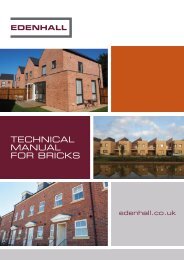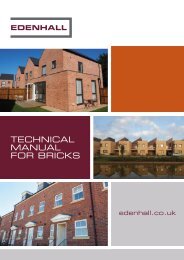You also want an ePaper? Increase the reach of your titles
YUMPU automatically turns print PDFs into web optimized ePapers that Google loves.
6. What is the lifespan of <strong>Edenhall</strong> bricks and how long are they guaranteed for?<br />
Concrete is a building material that has been used since the days of the Romans and in the form of precast masonry units since the<br />
beginning of the last century. <strong>Edenhall</strong> bricks in the UK have been produced since the 1950s and indeed were used in the construction<br />
of the original Calder Hall nuclear complex now Sellafield, which was opened in 1956. Since then the product has evolved and<br />
developed to a stage where it is now the preferred medium for a large number of developers and contractors. One of the prime benefits<br />
is their inherent frost resistance and durability derived from their increased strength as they age. Consequently, provided they have been<br />
used in the appropriate manner and location they should be suitable for use in excess of 60 years.<br />
7. What coloured mortars can be used to match <strong>Edenhall</strong> facing bricks?<br />
Most of the major pre-mixed mortar suppliers can supply colour swatches or samples of different coloured mortars. These are a better<br />
option than trying to select off a printed page. Site batching using pigments rarely gives satisfactory results unless it is for small quantities<br />
where one batch of mix will suffice. Reproduction of consistent coloured mixes on site is difficult due to changes in moisture content, mix<br />
time or dosage rates. Typically the advice is to choose between a complimentary or contrasting mortar, the latter tending to give a more<br />
dramatic impact but is less forgiving on the quality of the brickwork. Ref. <strong>Edenhall</strong> BTB 4: Mortars for Concrete Masonry Products.<br />
8. What are the preferred mortar joint profiles for <strong>Edenhall</strong> bricks?<br />
Choice of mortar and its finished profile can have a profound effect on the final appearance and performance of a finished wall. The<br />
choice of joint should be considered in respect not only of the finished appearance but also the brick type and level of exposure. For<br />
example, a heavily recessed or stripped joint may give the desired aesthetic effect but it is not recommended in areas of high exposure<br />
or where full cavity fill is used. By comparison a flush joint is hard to compact fully and should only be used in sheltered or internal<br />
locations. In all cases full bedding of the mortar bed and complete filling of the perpends is essential due to the low-medium absorption<br />
of the bricks which tends to throw water towards the joints. Ref. <strong>Edenhall</strong> BTB 4: Mortars for Concrete Masonry Products.<br />
9. What are the differences between using silo batched or pre-mixed mortars compared with site batching and mixing?<br />
Silo based and pre-mixed factory produced “tub” mixes offer consistency and convenience of mix. The silo based mixes can have their<br />
workability adjusted on site to suit the suction of the masonry whilst the retarded tub mixes may require additional time to stiffen before<br />
final tooling of the joint can be carried out.<br />
Site batching and mixing on site can be suitable for smaller works but can also be variable in consistency, especially if coloured mixes<br />
are required.<br />
In all cases it is important that the correct specification of mortar is used. Under the latest standards the old volumetric method of<br />
specifying mortars, eg. 1:1:6, has been superseded by a nominated mortar grade, eg. M4 (4N/mm 2 strength). Due to the safety factors<br />
in manufacturing the mortar suppliers may offer a mortar with a strength of 5-6N/mm 2 . Strong mortars can contribute to potential<br />
cracking risk and it may be prudent for the customer to confirm the likely actual strengths whilst specifying the mortar. Ref. <strong>Edenhall</strong><br />
BTB 4: Mortars for Concrete Masonry Products.<br />
10. How can I best achieve a clean, even joint in the brickwork?<br />
The key to achieving good quality brickwork is to ensure that the mortar consistency is adjusted to reflect the characteristics of the brick.<br />
As <strong>Edenhall</strong>’s bricks tend to have low-medium absorption characteristics they are suited by a “stiffer” mortar similar to that required for<br />
Clay Engineering Bricks. If the mortar is too wet there is a tendency for the excess to be squeezed out and this could lead to “smearing”<br />
when striking off with a trowel. To assist in all areas of jointwork the main areas to focus on are to ensure that the bricks and brickwork<br />
are kept dry and protected and that the workability of the mortar is correctly adjusted. Ref. <strong>Edenhall</strong> BTB 4: Mortars for Concrete<br />
Masonry Products.<br />
11. How important is mortar quality within a wall?<br />
The grade and quality of mortar has a crucial part in the performance of a brick wall particularly in relation to its durability, weather<br />
fastness and resistance to any potential cracking. Mortar consists of over 17% of the wall area and the correct choice is crucial.<br />
Under the old Standards, mortar was specified by volume eg. 1:1:6, that is one part of cement, one part of lime and six parts of sand.<br />
This traditionally gave a mortar strength of around 4N/mm 2 . Mortars now are designated by strength category, eg. M4, which in theory is<br />
equivalent to 4N/mm 2 . In practice, because that is a minimum strength requirement, pre-mixed mortar suppliers have to take<br />
account of strength variations and hence average strengths maybe 6N/mm 2 so that there are no results less than 4N/mm 2 . The same<br />
analogy applies to <strong>Edenhall</strong> bricks. In order to claim a minimum strength of 22.5N/mm 2 the actual brick average strength may run at<br />
28-32N/mm 2 . The strength of mortar therefore is particularly important in relation to a risk of cracking within a wall.<br />
As well as constituting 17% of the overall area, mortar differs from bricks in three ways:<br />
• Mortar has a higher mix water content than bricks<br />
• Mortar has a higher cement content than bricks<br />
• Mortar is made with finer aggregate than bricks<br />
Consequently mortar has a higher shrinkage and moisture movement value than <strong>Edenhall</strong> bricks. The stronger the mortar the greater the<br />
risk of cracking.







